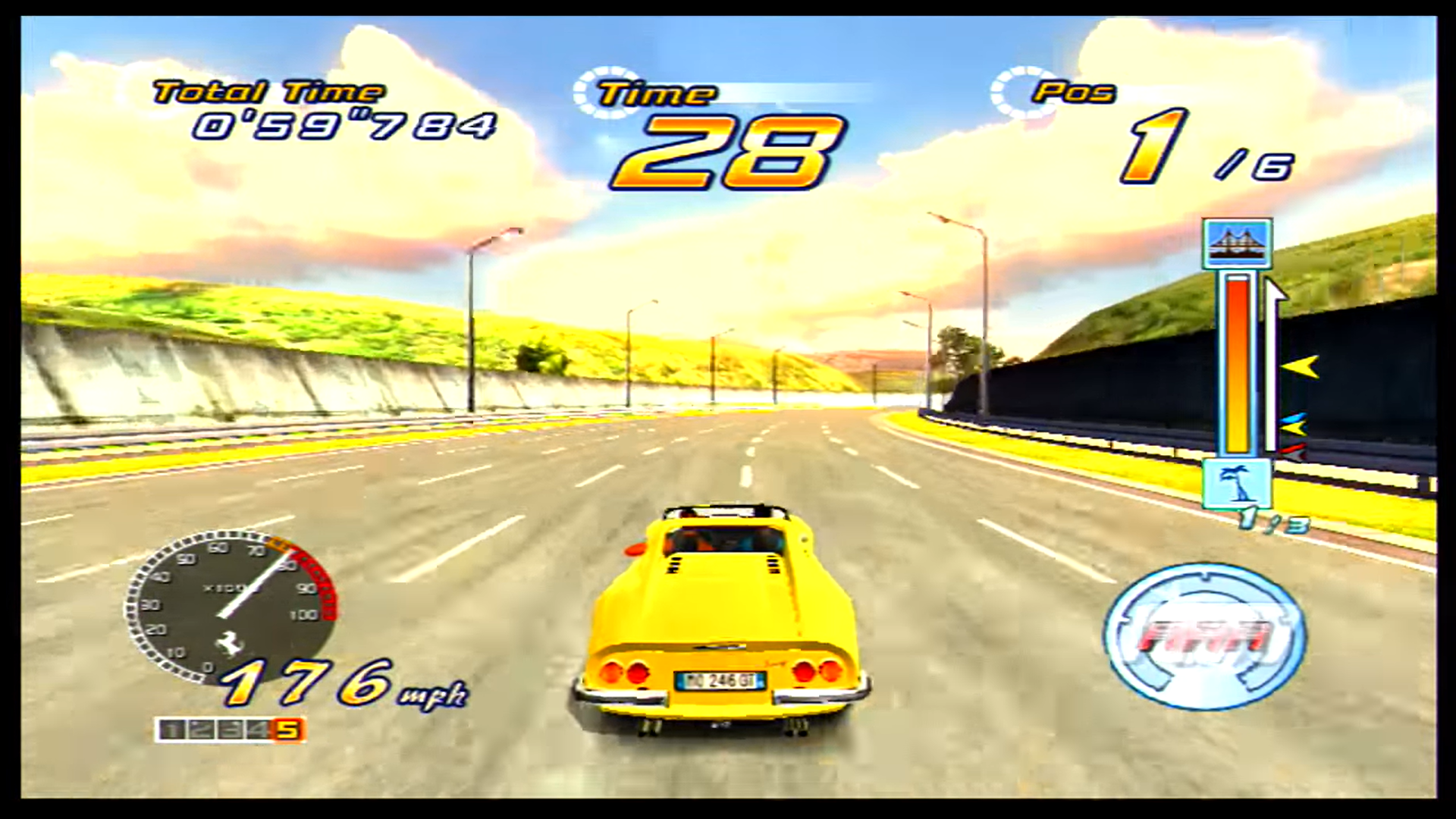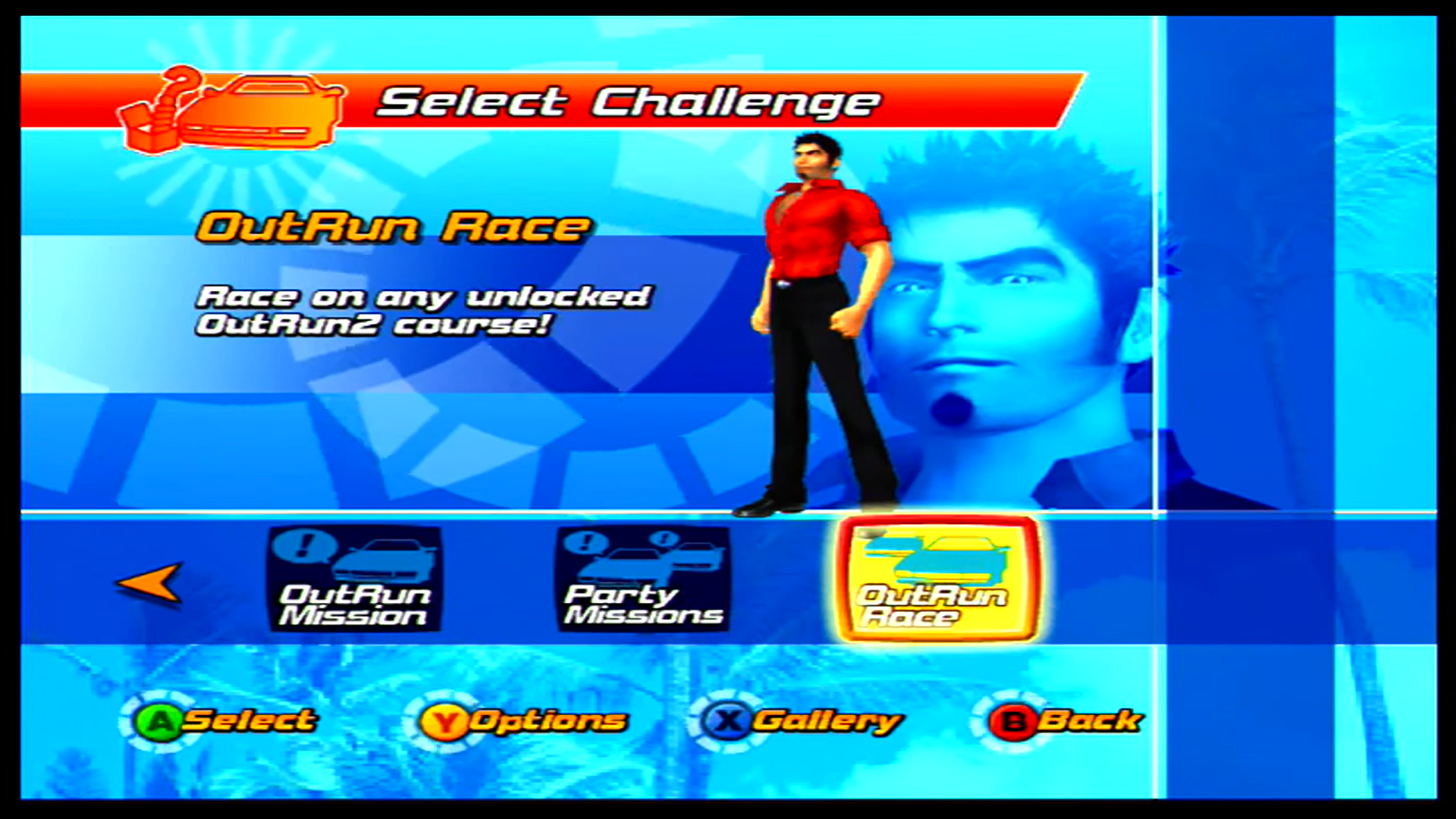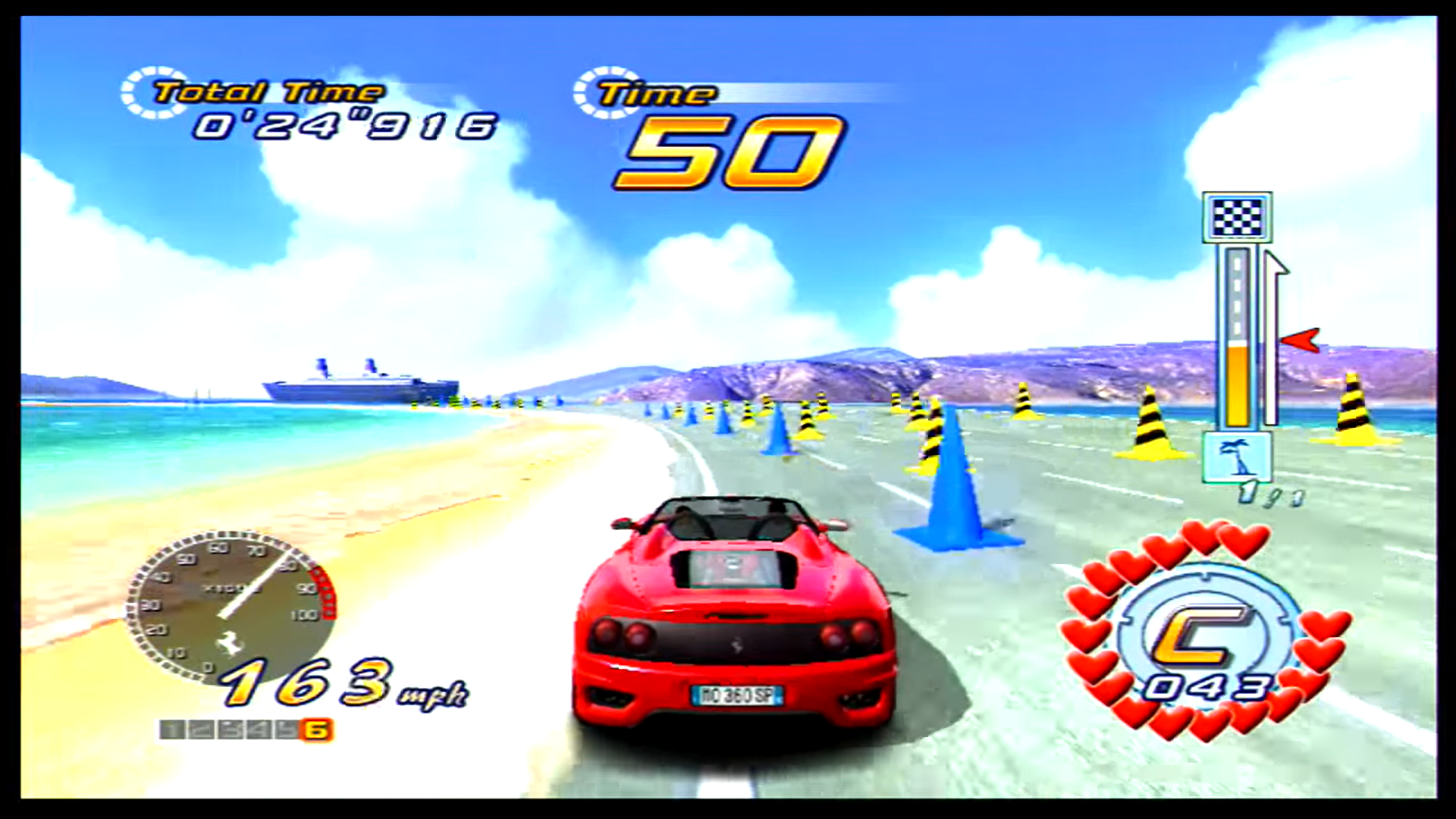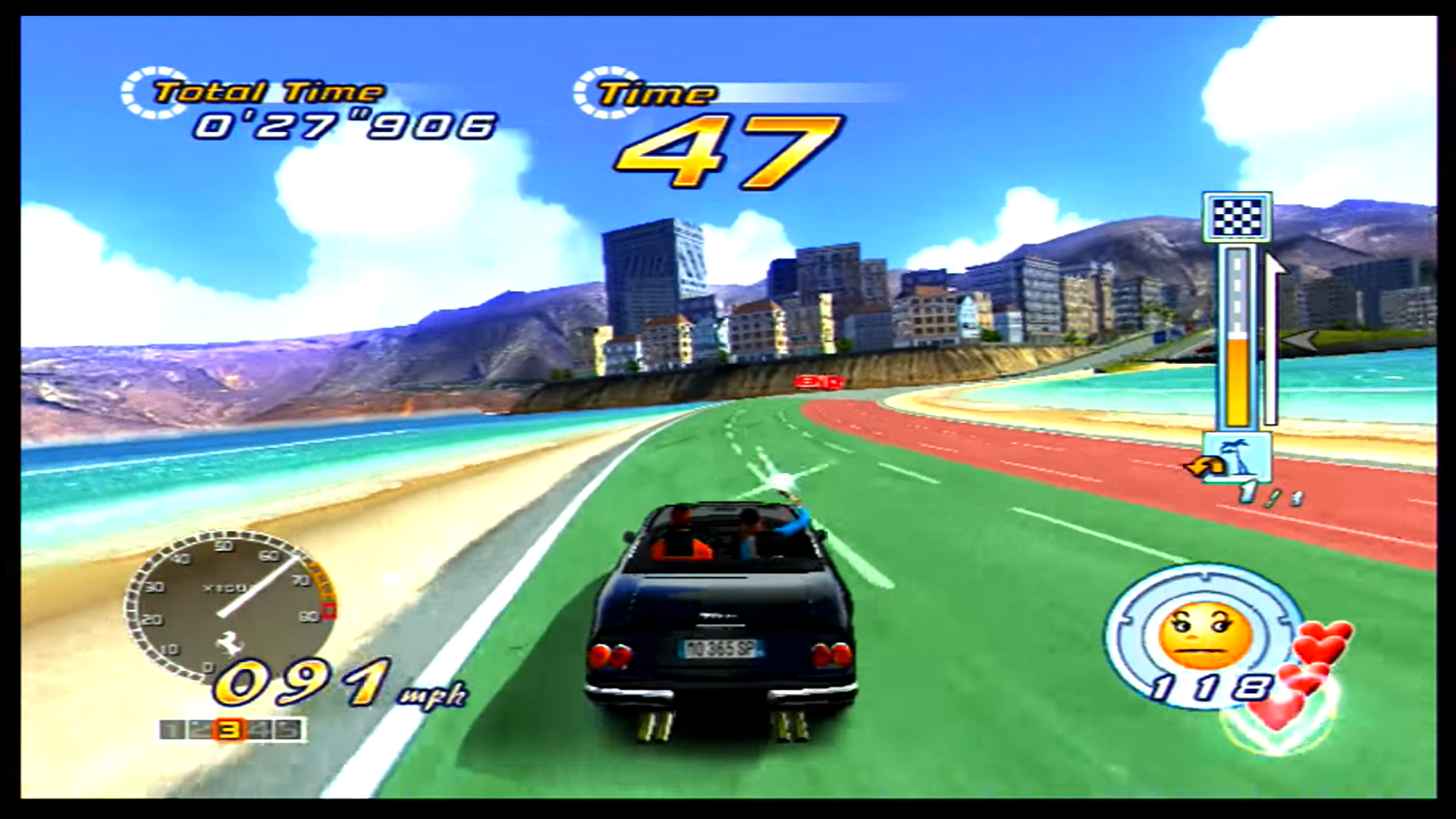Celebrating 20 rubber-burning years of OutRun 2
Holiday Long Read | Retro Gamer's 'The Legend Lives On' series hits the grid with a free-wheeling classic

Sega hasn't always had a perfect record when it comes to updating its popular franchises. We may praise Sonic Generations, After Burner: Climax and Streets Of Rage 4, but then we remember Shinobi X, Golden Axe: Beast Rider and Sonic Boom: Rise Of Lyric. Such potential for disaster is surely why Sega waited 17 years before it dared to release OutRun 2. It wasn't the first follow- up to the revered 1986 original, but it was the first in which original creator Yu Suzuki and his AM2 team could update the game for a new generation – both in terms of hardware and audience.
Their trick was to look at the original and consider what worked – the sense of freedom offered by the branching route, the amazing multi-tune soundtrack, the whole breezy blue sky vibe – and ensure that was all replicated in the sequel. But crucially they also looked at what didn't work.
For many Out Run is a true pedestal game. We remember the first time we played it in the arcades and it was so far in front of everything else that it left an indelible mark. We tend to forget that it could be a frustrating, overly difficult experience where a couple of crashes were enough to end your game. We overlook the fact you had to actually use the brakes on the more torturous stages. Pleasant nostalgia hides all of this from us, but thankfully AM2 was not similarly affected when developing OutRun 2. The key was the introduction of drifting. The twists and turns were all still there, but now you could take them sideways, effortlessly sliding around the corners without losing speed. And if you did crash out, you'd be up and running much more quickly. But even though it was easier it was not dumbed down. By learning each stage and working out the best racing lines you could shave seconds off your time. The game even included a Time Attack mode that provided players with traffic free routes on which to secure their best times.
Pedal to the mettle


This feature originally appeared in Retro Gamer magazine. For more in-depth features and interviews on classic games delivered to your door or digital device, subscribe to Retro Gamer.
Alternatively, if you wanted something more frivolous there was the Heart Attack mode where your somewhat bossy female passenger gave you a series of challenges to complete. The pure nostalgia stuff was all in there too. The fifteen-stage, five-goal branching structure was reinstated, with Europe's scenic routes once again the backdrop. The Testarossa returned, along with seven other licensed Ferrari models. And Radio Sega was also back, playing the three classic tunes from the original (in rearranged form) plus four brand-new compositions. The result was not just a considered update of Out Run but a game that Edge magazine called, "A pinnacle of the arcade racing tradition, a peak that may never again be topped."
OutRun 2 debuted in arcades in December 2003 and was available as a single and a twin cab. Machines could also be linked to allow up to four players to compete against each other. The game ran on Sega's Chihiro hardware which was based on Xbox architecture, so for the inevitable home version it made sense to exclusively target Microsoft's console. For conversion duties Sega looked at a number of external developers and eventually settled on Sumo Digital, a new studio based in Sheffield. Sumo might have been new, but its founders and most of its staff (which numbered less than 20 at the time) were all former employees of Gremlin Interactive which had closed down in 2003.
One of those ex-Gremlins was Steve Lycett, who was a producer on the conversion and also a huge Sega fan. "I still remember the day we found out we'd been asked to bring it to Xbox," he says. "I'd been tracking OutRun 2 online since it was announced for the arcades so it was a dream come true to be part of such a legacy. I grew up in the era of arcades and Sega was a real innovator throughout that period. My holy trinity of arcade games is Space Harrier, Out Run and After Burner. Between Yu Suzuki and AM2, you just couldn't wait to see what they did next."
An obvious question is, "Why Sumo?" According to Phil Rankin, lead programmer of the Xbox version, it was simply a case of word of mouth. "We'd done some work for Codemasters, adding online multiplayer to a football game as I recall. Somehow this led to conversations with Microsoft and Sega that ultimately resulted in Sega awarding us the contract for OutRun 2. The first the development team knew about the project was when a van pulled up one day and delivered the arcade machine to our offices. As this was the first big project that Sumo had worked on, I think it's fair to say we were quite excited."
Weekly digests, tales from the communities you love, and more

Despite the distraction of having the coin-op in the office, Phil and his fellow programmers began weighing up the task of converting the game to the Xbox. The hardware might have been alike but this was no simple porting job. "The main challenge was memory," says Phil. "The arcade board had double the memory of the Xbox, so we had to find a way of squeezing a game that already used every byte into half the space. This involved a lot of careful analysis of the levels of detail to understand what was important and what could be thrown away. Switching from a wheel to the Xbox controller was another challenge. AM2 had already started this work, but it was far from complete. We wanted to maintain the 'feel' of the arcade game while making it playable for everyone. You don't know how many variations on the control scheme we tried in order to get it just right.
"Then there was the Xbox hard drive which was… quite slow," Phil says, coughing for effect. "We had to work out how to make those incredibly detailed levels load during the short time the player was driving through the 'bunki' [the connecting section between levels]. You will still occasionally get a situation where you reach the end of the bunki and the level hasn't finished loading. Finally, we decided to throw in a bunch of new missions and stages, and we had to do this while maintaining the whole Out Run vibe, and still fitting everything into memory and onto the disc."
Into gear

Ah yes, the extras. In addition to the three main modes from the arcade game, the Xbox version included exclusive content that was designed by Sumo with input from Sega. "There were concerns that a straight arcade conversion at £40 would lead to negative reviews," says Steve. "This led to the inclusion of online play, the Challenge mode and the new courses." By completing the challenges, which were a mixture of Heart Attack missions and races, players could unlock cars (four new Ferraris joined the garage), music (11 additional tracks were added, including Euro remixes of the original arcade tunes by Richard Jacques – see Richard Jacques Q&A) and even a faithful version of the original OutRun arcade game.
Reversed versions of all 15 courses were also unlockable, but it was the bonus stages which wowed the crowd as they were taken from two Sega games which have otherwise never received a home version. "It was a suggestion from AM2 to include tracks from other AM2 games," reveals Steve. "We needed tracks that allowed the user to drive and drift, and from the available titles Daytona USA 2 and Scud Race fit the bill. We still had to make modifications for these tracks to loop and some tweaks to fit the OutRun 2 drifting model, but I think a lot of Sega fans appreciated these additions." With all the new content added and a release date of October 2004 finalised, the team received a hand from Sega producer Nobuyuki Minato to help get the game over the finish line. "I remember Minato-san flying over to the UK," says Phil, "and almost living in the office for a couple of weeks as we finalised everything from car handling to challenge difficulties. He was a star."
The game hit its release date but the OutRun 2 journey was only just beginning for Sumo. The next stop was a version for the Japanese Xbox which received extra levels of scrutiny from Sega, according to Phil. "For the EU and US versions we reduced a lot of trackside detail, but for the Japanese version all that geometry had to go back in, or be argued about tree by tree, bush by bush!" These changes are most evident in the bonus stages which look closer to the coin-op versions in the Japanese release.
Sega was not done with OutRun 2 either. While Sumo was busy working on the Xbox conversion, AM2 was prepping an enhanced version for arcades entitled OutRun 2 SP (Special Tours). This was no mere lick of paint however. SP introduced 15 brand-new stages, all set in the Americas, in addition to the original's 15 European stages. Numerous changes were made to the gameplay too, with the main ones being the ability to slip-steam other vehicles for a speed boost, and the introduction of Rivals – fellow Ferrari drivers who joined you on the journey, rather like the Porsche-driving dude from Turbo OutRun. SP also adopted another feature of Turbo OutRun in the reintroduction of the 15-stage continuous route which did away with the forks in the road. This extended race was available for both the SP and original courses, although the more devious operators could choose to up-charge you an extra credit to participate. The final nod to the past was the addition of the original soundtracks from both Out Run and Turbo OutRun.
Probably the biggest change to SP was that it was easier than the original. The new courses were not necessarily tamer, but crashes were more forgiving and drifting felt like it was more 'on rails' than before. To compensate for expert drivers, livelier 'tuned' versions of each car were added to Time Attack mode. Talking of cars, two new Ferraris joined the original eight – the 250 GTO and the 512 BB. Both of these cars had already appeared in the Xbox version of OutRun 2, but that was the only new feature the two games shared. Phil confirms, "I don't remember us seeing anything of SP while we were developing the Xbox version. We knew it was happening, but it didn't directly influence anything we did."

OutRun 2 SP debuted in arcades in December 2004 and sported a racing yellow colour scheme as opposed to the original's Ferrari red. It was available as a standard sitdown type and a deluxe version based around a replica of the 360 Spider (it was still static mind, hydraulic cab fans). As before, up to four units could be linked together. Following its successful conversion of the original game, Sumo was invited to work its magic on SP. This time however it would not be exclusive to the Xbox and would also appear on the PS2, PSP and PC. Pete Ellacott programmed the PS2 version and he remembers the sizable challenge this presented. "The arcade hardware had double the memory of the retail Xbox, but the Xbox had double the memory of the PS2, so the PS2 version had to be a quarter of the size of the arcade. The Xbox GPU was nearly twice the speed of the PS2 GPU too. The audio was also a lot of work, simulating all the crazy multi-voice engine samples. It used something like 32 different engine samples at different RPMs that we blended as you accelerated and changed gear. Oh and all the code comments were in Japanese."
"I recall we got kicked off an early online translation tool for using it too much to translate all the comments into English," chips in Steve. And then there was the version for the PSP handheld. "This required us to write a custom engine and do a lot of optimisation," reveals Phil. "We had gained a lot of experience working with the PSP on both TOCA Race Driver and Virtua Tennis: World Tour, so this helped a lot when it came to optimising the renderer to squeeze every last drop of performance out of the machine that we could." The PSP version ran at 30fps, half that of the other versions, but it was still an extraordinary achievement. The PS2 version meanwhile was admirably close to the Xbox release, while the PC version was able to output the game at HD resolutions.
The last lap

The game arrived in March 2006 and was titled OutRun 2006: Coast 2 Coast. It was the most generous release yet, featuring all 30 stages, 28 music tracks and 15 Ferraris. Each car was also available in a supercharged 'OutRun' class. "We developed the different liveries and addons for the tuned cars, working directly with Sega and Ferrari on those," reveals Steve. "That was one of those special moments in game development where you're literally working directly with real Ferrari designers and engineers to collaborate on making something authentic to the brand."
The extras were unlocked by completing missions in the main Coast 2 Coast mode, which was like a hyperactive spin on the original Xbox version's Challenge mode. What was missing this time though were the celebrated bonus stages from other AM2 games and the original Out Run coin-op. Mitigating, Steve explains, "We needed to make three sets of every track, one for Xbox, one further reduced for PS2, then an even further reduced version for PSP. We also added in reverse versions of the tracks that needed to be completely reworked. By the time we'd done all that, additional tracks were just not possible in time. Same with the 1986 arcade version." Sumo was allowed more time to produce the Japanese PS2 version which was retitled OutRun 2 SP. The earlier extras were still absent, but some missing goal animations were restored and Clarissa's outfit was a little more revealing, plus various other fixes and optimisations were made.
Shortly after the release of OutRun 2006, the game returned to arcades one final time. OutRun 2 SP SDX (Super Deluxe) was the game fully evolved into its 8m-wide final form, featuring four two-seater Ferraris that now moved as you played (there was also a two-car DX version). Each car included a pair of controls, inviting two players to share driving duties. The actual game content was the same as SP, with the only difference being that it was running on Sega's new PC-based Lindbergh hardware which outputted at a higher resolution.
Consoles also received a more defined version in 2009 in the form of OutRun Online Arcade. Running at 1080p on Xbox 360 and PS3, the game looked better than ever – but content-wise it was limited, featuring just the SP tracks and no extras. Steve reveals that Sumo's hands were tied as it was released as a digital download. "At the time we had to work within size limitations. Xbox Live Arcade games had to be able to be downloaded and installed onto memory units for players who didn't have a hard drive. That restricted the overall size of the game and so the choice was made to only include the SP tracks. We always had the intention to either do a version with the original tracks – or do them as DLC. But by that point we were pretty stacked with other projects."
Regardless, OutRun Online Arcade was a blast played in full HD, but it wouldn't last due to Sega losing the Ferrari licence. As a result it was removed from PSN in 2010 and XBLA in 2011, plus the PC version of OutRun 2006 was dropped from Steam around the same time. "Unfortunately the Ferrari licence probably limits the scope for any future versions," says Phil, when asked about what's next for OutRun 2. "Having said that, I would bite your hand off to work on a remastered version. Someone make it happen, please." Steve adds, "I have tried and will continue to try to encourage someone to let us make another OutRun game. We are all big fans and we'd love to do another one day."
A new OutRun 2 collection may well happen at some point, especially as Sega recently announced plans to leverage more of its iconic properties. And dare we dream about OutRun 3? But for now, thanks to Sumo's efforts, we can still enjoy OutRun 2 at home. Both games can be played on the Xbox 360 via backwards compatibility (but alas, not the new Xboxes), and the PC version of OutRun 2006 runs brilliantly on even the most basic setup. And for those with more modern PCs there's FXT, a remarkable mod by Howard Casto designed to enhance the PC version and make it as arcade accurate as possible.
"The work being done by fans is incredible," says Steve. "I've been keeping an eye on community efforts to update the PC version to take advantage of modern hardware, restore some elements we couldn't include in time and support force-feedback wheels. Equally, you can now run the PSP version in VR via emulation – and look around as you play. I think it shows the strength of love for the games. And it shows there is a desire to see more."
Of course, for the true OutRun 2 experience you need to play the coin-op and it remains a mainstay in many arcades (typically upgraded to the SP version). In specialist venues you may even find larger installations. The UK's Arcade Club has a four-player SP deluxe at its Bury location and a two-player SP DX (soon to be four-player SP SDX!) at Leeds. So there are still opportunities to play, enjoy and challenge others on the coin-op. "There's a good chance you'll find I've left a Time Attack high score if you use my preferred car the 512 BB in any arcades near Sheffield," says Steve, smiling. "I also used to have a record on the online leaderboards where you could send scores to – 'til I mentioned that and a bunch of fans recorded better times to knock me out of the top ten!"
Twenty years on from its debut, OutRun 2 and Sega's beautiful journey are still in arcades, in our homes, in our hands and in our hearts.
This feature originally appeared in Retro Gamer magazine. For more fantastic in-depth features, interviews, and more on classic games, subscribe to Retro Gamer or pick up a single issue today.


